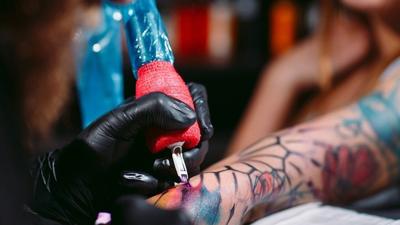![]()
Think before you ink: What you need to know about tattoo safety from a dermatologist
Tattoos are generally safe, but they aren't risk-free. Here's what to consider before going under the needle.
Practicing dermatology doesn’t just involve treating rashes and sunburns and administering cosmetic injectables. With 32% of Americans having a tattoo, including 22% who have more than one, it’s common to see another type of condition: regret. That feeling isn’t just about a tattoo artist making an error with a design or using the wrong color of ink. It’s about serious medical risks associated with tattoos that can range from adverse reactions, which are relatively common, to the inadvertent masking of serious conditions such as skin cancer, Northwell Health reports.
During the tattoo process, it's possible to contract bacterial infections such as staph, strep or atypical mycobacteria (it can cause fever, skin lesions or joint pain), or viral infections like warts or molluscum contagiosum — a virus that produces dome-shaped bumps with a dimple in the center. And while it’s rare, some people have contracted bloodborne diseases such as hepatitis B, hepatitis C, and HIV. Those considering getting a tattoo should be aware of the risk.
Reactions and infections
A patient might come to a practice with an allergic reaction to tattoo ink, which is typically a mixture of pigments, sometimes metals, and other chemicals not regulated by the Food and Drug Administration. Some mild irritation or swelling after getting inked can be normal, but when the tattoo develops pronounced swelling, itching, flaking or scaly skin, or skin tags and nodules, it’s time to see a dermatologist for topical creams or ointments and steroids to treat the reaction. It’s also important for patients to note the growth of hard, bumpy tissue or if they’re experiencing chills, hot flashes, or fever, which can be signs of an infection.
Granulomas, cancer
Like an allergy, the body can react to a tattoo as if it’s a foreign invader, causing red bumps on the skin called granulomas, a small area of inflammation formed by the accumulation of immune cells. Topical and injectable medications often can treat granulomas, but sometimes they can grow repeatedly, and patients may need to have the tattoos removed.
Tattoo ink — especially dark pigments like black — can also mask more harmful growths. A patient might have a mole that was difficult to see during a full-body exam because it was next to a dark tattoo, for example. The mole was cancerous and had to be removed, along with some of the tattooed skin.
It’s also important for people getting tattoos to be aware of lesser-known medical risks and complications. They can include:
- Metallic pigments in some tattoo inks can cause burning, swelling, or distort images during an MRI scan.
- Those with compromised immune systems, bleeding disorders, a history of keloids (abnormal scar tissue), or certain active skin conditions may face complications.
- The effectiveness of infection prevention relies on diligently following aftercare instructions to promote healing and prevent infections
Tattoo removal
Patients sometimes feel regret when they’re faced with having tattoos removed. It’s a tricky process because tattoo ink pierces the skin barrier to place ink granules below the skin’s surface. That makes tattoo removal time-consuming, expensive, and painful.
It usually takes seven to 10 sessions with a strong laser to remove tattoos, using a concentrated pulse to heat the ink in the skin and dissolve it. Skin must heal for six to eight weeks between laser sessions, and the body must clear the ink. Sometimes lasers significantly lighten or fade tattoos so they’re less noticeable, but do not remove them altogether. Skin discolorations, either dark (hyperpigmentation) or light (hypopigmentation), can remain. Additional tattoo removal options include dermabrasion, using a sanding device to remove layers of skin to allow ink to leach out, and surgical excision, cutting out the tattoo.
Research reduces regret
Getting a tattoo doesn’t have to lead to medical complications or regret if people check to make sure that the tattoo shop and the tattoo artists are licensed, and that they use:
- Single-use, disposable needles
- An autoclave for disinfecting reusable equipment
- Techniques that prevent infection, such as cleansing the site of the tattoo before it’s applied and proper hand washing by the tattoo artist
There is beauty and artistry in tattoos, but it’s important to know that the process can come with medical complications for some. People who are fully informed of the risks, choose licensed artists who follow stringent hygiene practices, and pay close attention to their skin’s response, are likely to minimize both health problems and regret.
Raman Madan, MD, is a board-certified dermatologist at Northwell Health Physician Partners Dermatology at Huntington.
This story was produced by Northwell Health and reviewed and distributed by Stacker.





















(0) comments
Welcome to the discussion.
Log In
Keep it Clean. Please avoid obscene, vulgar, lewd, racist or sexually-oriented language.
PLEASE TURN OFF YOUR CAPS LOCK.
Don't Threaten. Threats of harming another person will not be tolerated.
Be Truthful. Don't knowingly lie about anyone or anything.
Be Nice. No racism, sexism or any sort of -ism that is degrading to another person.
Be Proactive. Use the 'Report' link on each comment to let us know of abusive posts.
Share with Us. We'd love to hear eyewitness accounts, the history behind an article.